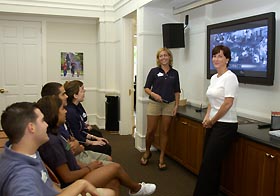|
This is an archived article.
For the latest news, go to the Advance Homepage
For more archives, go to the Advance Archive/Search Page. |
||
|
Lodewick Visitors Center A Friendly A telephone rings at the front desk, not far from Meg Malmborg's office. A student answers: "Lodewick Visitors Center. This is Jennifer. How may I help you?" There's a smile in her voice. "That's the way all of us answer the telephone," she says. "It never varies. And the phone has to be picked up by the second ring."
The student's greeting is just one example of the careful attention to detail that Malmborg and her staff offer at the visitors center to make people feel welcome. "This is the first impression people are going to get, so you have to get it right," says Malmborg, who heads the visitors center. "Sometimes there isn't a second chance." The Lodewick Visitors Center, located close to the core of campus at the intersection of North Hillside and North Eagleville Roads, opened its doors in August 2000. It is the first point of contact for people who visit UConn to tour the campus, attend cultural, social, and sporting events, participate in summer programs, or visit friends and relatives at the University. "It's a point of greeting for everyone," Malmborg says, adding that about 40,000 people pass through the center each year. The majority - about 85 percent - are prospective students and their families. The center offers tours of campus nearly every day, and is open throughout the year, seven days a week, except for major holidays. The building is welcoming. Light pours through walls of windows. A 'living room,' appointed with comfortable chairs and sofas, offers a spot for guests to browse through brochures offered at the front desk, while enjoying complimentary refreshments. A computer is available for visitors to use, and a large campus map on the wall helps newcomers plan their stay. On this day, prospective students and their parents gather in the living room waiting for a tour to begin. They are ushered to a 60-seat presentation room outfitted with a flat screen monitor, where student tour guides lead an entertaining and informative introductory presentation to the University before the visitors see the campus. According to Malmborg, the concept of a visitors center was the result of focus groups and surveys, which suggested the University needed a central 'front door' for guests and a reinvigorated tour program. The staff worked closely with the admissions office to develop a program tailored to prospective students and their families. "The Lodewick Visitors Center is an integral part of the University's strategic outreach, marketing, and recruiting activities," says John Barry, director of university communications. "Everything from signage and the materials we send out, to what people see when they walk into the center - it's all carefully thought through." The center was funded by alumni Philip and Christine Lodewick. Philip Lodewick, who holds both bachelor's and master's degrees in business from UConn, is actively involved in many University projects, and is currently head of the Storrs Downtown Initiative. Christine Lodewick, who earned a master's in speech pathology from UConn, is a member of the Alumni Association board of directors. Before the center was built, there was no starting point for people who came to the University, Malmborg says: "They might go to the Student Union or to Parking Services, but we didn't have an easily identifiable location where the public could get information about UConn and orient themselves to the campus." The tour program at that time lacked a true home: tours started in the Student Union. "Now," says Malmborg, "we have a far more comprehensive program. Students at the visitors center also serve as general information resources for the public. We've really enhanced customer service." In addition to assistant director, Pamela Pellegrine and administrative assistant Renee Harrington, Malmborg has a student staff of about 45. Malmborg says in conjunction with the building of the center, the campus map was redesigned and better campus signs installed. Additional supporting materials include information about schools and colleges, cultural centers, museums, and events taking place on campus, and also admissions packets. A student tour guide hands Malmborg a stack of papers. They are evaluations from people who went on the last tour. "These are very important," says Malmborg, who reviews each one. "The feedback is constructive. It makes us question what we do and why we do it." Malmborg says the center tries to accommodate the feedback. "In the past, for example, some people said they wanted to see more buildings, while others said they thought the tour was too long. So we added some more buildings, but without adding much length to the tour." The hour-and-a-half-long tour includes stops at the Information Technology building, the Wilbur Cross building, Homer Babbidge Library, the School of Business, McMahon residence hall, Gampel Pavilion, and the student recreational facility. A lot of thought goes into the order of the tour. "We show an academic building first," Malmborg says, "because we want to stress the excellence of our academic programs. We gear our tour program around what prospective families want to see, as well as what we want to highlight." Malmborg and Barry say it has been a group effort to make the visitors center what it is today. "When we learned through the evaluations that people wanted to see a dorm room, we worked with residential life and built a model room," Barry says. "When we knew we were going to have thousands of people touring on the weekends, we contacted leadership in the schools of business, engineering, the library, and athletics and made sure the doors of the building would be open. "We all work together," he adds, "and understand the center's importance to University goals and objectives." |

